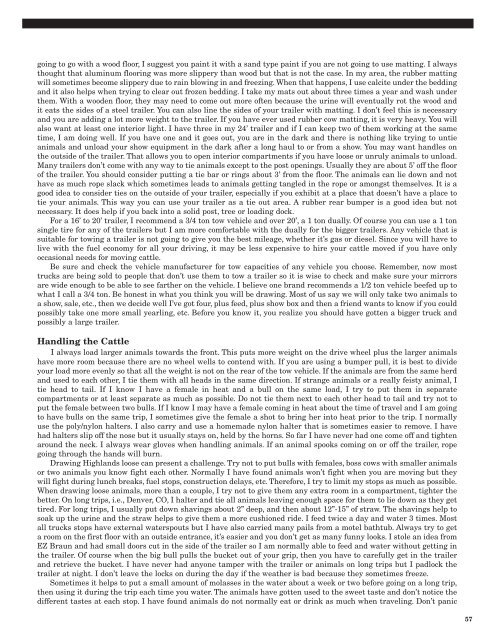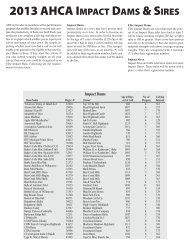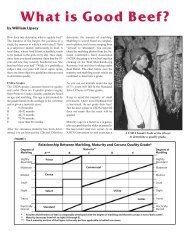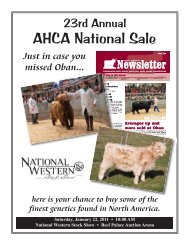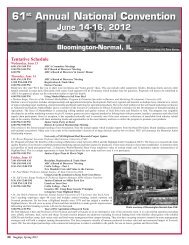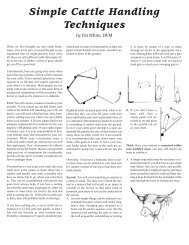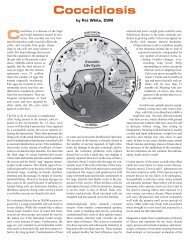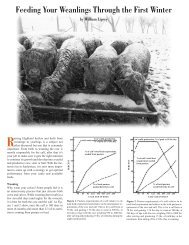The Bagpipe - American Highland Cattle Association
The Bagpipe - American Highland Cattle Association
The Bagpipe - American Highland Cattle Association
You also want an ePaper? Increase the reach of your titles
YUMPU automatically turns print PDFs into web optimized ePapers that Google loves.
going to go with a wood floor, I suggest you paint it with a sand type paint if you are not going to use matting. I always<br />
thought that aluminum flooring was more slippery than wood but that is not the case. In my area, the rubber matting<br />
will sometimes become slippery due to rain blowing in and freezing. When that happens, I use calcite under the bedding<br />
and it also helps when trying to clear out frozen bedding. I take my mats out about three times a year and wash under<br />
them. With a wooden floor, they may need to come out more often because the urine will eventually rot the wood and<br />
it eats the sides of a steel trailer. You can also line the sides of your trailer with matting. I don’t feel this is necessary<br />
and you are adding a lot more weight to the trailer. If you have ever used rubber cow matting, it is very heavy. You will<br />
also want at least one interior light. I have three in my 24’ trailer and if I can keep two of them working at the same<br />
time, I am doing well. If you have one and it goes out, you are in the dark and there is nothing like trying to untie<br />
animals and unload your show equipment in the dark after a long haul to or from a show. You may want handles on<br />
the outside of the trailer. That allows you to open interior compartments if you have loose or unruly animals to unload.<br />
Many trailers don’t come with any way to tie animals except to the post openings. Usually they are about 5’ off the floor<br />
of the trailer. You should consider putting a tie bar or rings about 3’ from the floor. <strong>The</strong> animals can lie down and not<br />
have as much rope slack which sometimes leads to animals getting tangled in the rope or amongst themselves. It is a<br />
good idea to consider ties on the outside of your trailer, especially if you exhibit at a place that doesn’t have a place to<br />
tie your animals. This way you can use your trailer as a tie out area. A rubber rear bumper is a good idea but not<br />
necessary. It does help if you back into a solid post, tree or loading dock.<br />
For a 16’ to 20’ trailer, I recommend a 3/4 ton tow vehicle and over 20’, a 1 ton dually. Of course you can use a 1 ton<br />
single tire for any of the trailers but I am more comfortable with the dually for the bigger trailers. Any vehicle that is<br />
suitable for towing a trailer is not going to give you the best mileage, whether it’s gas or diesel. Since you will have to<br />
live with the fuel economy for all your driving, it may be less expensive to hire your cattle moved if you have only<br />
occasional needs for moving cattle.<br />
Be sure and check the vehicle manufacturer for tow capacities of any vehicle you choose. Remember, now most<br />
trucks are being sold to people that don’t use them to tow a trailer so it is wise to check and make sure your mirrors<br />
are wide enough to be able to see farther on the vehicle. I believe one brand recommends a 1/2 ton vehicle beefed up to<br />
what I call a 3/4 ton. Be honest in what you think you will be drawing. Most of us say we will only take two animals to<br />
a show, sale, etc., then we decide well I’ve got four, plus feed, plus show box and then a friend wants to know if you could<br />
possibly take one more small yearling, etc. Before you know it, you realize you should have gotten a bigger truck and<br />
possibly a large trailer.<br />
Handling the <strong>Cattle</strong><br />
I always load larger animals towards the front. This puts more weight on the drive wheel plus the larger animals<br />
have more room because there are no wheel wells to contend with. If you are using a bumper pull, it is best to divide<br />
your load more evenly so that all the weight is not on the rear of the tow vehicle. If the animals are from the same herd<br />
and used to each other, I tie them with all heads in the same direction. If strange animals or a really feisty animal, I<br />
tie head to tail. If I know I have a female in heat and a bull on the same load, I try to put them in separate<br />
compartments or at least separate as much as possible. Do not tie them next to each other head to tail and try not to<br />
put the female between two bulls. If I know I may have a female coming in heat about the time of travel and I am going<br />
to have bulls on the same trip, I sometimes give the female a shot to bring her into heat prior to the trip. I normally<br />
use the poly/nylon halters. I also carry and use a homemade nylon halter that is sometimes easier to remove. I have<br />
had halters slip off the nose but it usually stays on, held by the horns. So far I have never had one come off and tighten<br />
around the neck. I always wear gloves when handling animals. If an animal spooks coming on or off the trailer, rope<br />
going through the hands will burn.<br />
Drawing <strong>Highland</strong>s loose can present a challenge. Try not to put bulls with females, boss cows with smaller animals<br />
or two animals you know fight each other. Normally I have found animals won’t fight when you are moving but they<br />
will fight during lunch breaks, fuel stops, construction delays, etc. <strong>The</strong>refore, I try to limit my stops as much as possible.<br />
When drawing loose animals, more than a couple, I try not to give them any extra room in a compartment, tighter the<br />
better. On long trips, i.e., Denver, CO, I halter and tie all animals leaving enough space for them to lie down as they get<br />
tired. For long trips, I usually put down shavings about 2” deep, and then about 12”-15” of straw. <strong>The</strong> shavings help to<br />
soak up the urine and the straw helps to give them a more cushioned ride. I feed twice a day and water 3 times. Most<br />
all trucks stops have external waterspouts but I have also carried many pails from a motel bathtub. Always try to get<br />
a room on the first floor with an outside entrance, it’s easier and you don’t get as many funny looks. I stole an idea from<br />
EZ Braun and had small doors cut in the side of the trailer so I am normally able to feed and water without getting in<br />
the trailer. Of course when the big bull pulls the bucket out of your grip, then you have to carefully get in the trailer<br />
and retrieve the bucket. I have never had anyone tamper with the trailer or animals on long trips but I padlock the<br />
trailer at night. I don’t leave the locks on during the day if the weather is bad because they sometimes freeze.<br />
Sometimes it helps to put a small amount of molasses in the water about a week or two before going on a long trip,<br />
then using it during the trip each time you water. <strong>The</strong> animals have gotten used to the sweet taste and don’t notice the<br />
different tastes at each stop. I have found animals do not normally eat or drink as much when traveling. Don’t panic<br />
57


